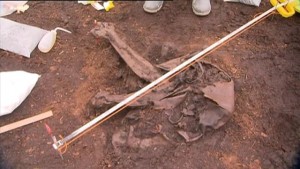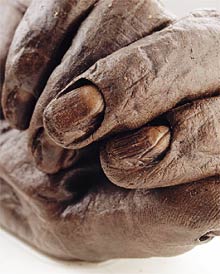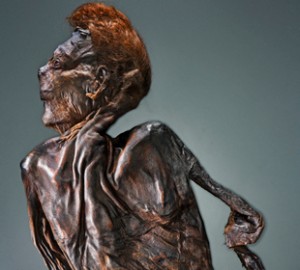Another ancient body has just been recovered from the depths of an Irish bog. This time the remains consist of a partial bog body that appears to have been covered in a leather bag (update: the leather bag may actually be the upper torso). The bog body, which may be the remains of a woman, was found just outside Portlaoise in Cul na Móna bog and is being excavated by archaeologists from The National Museum of Ireland.

This latest addition to growing a corpus of Irish bog bodies will hopefully reveal as much information as two recent peat land discoveries. These aforementioned bog bodies, Old Croghan man and Clonycavan man, form the centre piece of the excellent Kingship and Sacrifice display at the National Museum of Ireland. What is striking about these remains is their fantastic state of preservation, something which is characteristic of bog bodies in general. This is primarily due to the cold, acidic, oxygen-free conditions that persist beneath peat bogs and which prevent decay and mummify human flesh.

Old Croghan man was found in a bog beneath Croghan Hill in Co. Offaly and based on radiocarbon dating he died sometime between 362 BC and 175 BC . He was extremely tall measuring 6ft 6 in height and had well manicured hands suggesting that he was not used to manual labour. His last meal (analysed from the contents in his stomach) consisted of cereals and milk . However, he was shown to have had a meat rich diet for at least the 4 months prior to this (based on analysis of his nails). Clonycavan man, in contrast, was much smaller in stature, measuring just 5ft 2 in height. He was recovered from a bog in Co. Meath and only his upper torso and head survived. The remains were radiocarbon dated to between 392 BC and 201 BC and, unusually, his hair was spiked with pine resin (a very early form of hair gel). Furthermore, the trees from which the resin was sourced only grow in Spain and south-west France, indicating the presence of long distance trade routes.

Both men had been subjected to gruesome deaths, suggesting that they may have been ritually tortured and murdered. Old Croghan man had holes cut in his upper arms through which a rope of hazel withies was threaded in order to restrain him. He was then stabbed, his nipples sliced, before finally being cut in half across his torso. Similar overkill was also seen on the Clonycavan bog body. He had been disembowelled and struck three times across the head with axe and once across the body. This brutality is not confined to Irish bog bodies and has been paralleled on human remains from British and continental bogs. For example, the Lindow man bog body, displayed at London’s British Museum, was struck twice on the head, garroted, and had his throat cut.
The reasons behind these bog body killings remains uncertain but Ned Kelly of the National Museum of Ireland has suggested a very interesting theory (see Archaeology, No. 63, Vol 3, May/June 2010) . He believes that “these men were failed kings or failed candidates for kingship who were killed and placed in bogs that formed important tribal boundaries. Both Clonycavan and Old Croghan men’s nipples were pinched and cut. “Sucking a king’s nipples was a gesture of submission in ancient Ireland,” says Kelly. “Cutting them would have made him incapable of kingship.” The bodies served as offerings to the goddess of the land to whom the king was wed in his inauguration ceremony. According to Kelly, both men’s multiple injuries may reflect the belief that the goddess was not only one of the land and fertility, but also of sovereignty, war, and death. “By using a range of methods to kill the victim, the ancient Irish sacrificed to the goddess in all her forms,”.
It will be interesting to see if this latest bog body from Co. Laois represents another sacrificial victim to appease these pagan gods.
Related Posts
Bog butter find from Co. Offaly
Some links
RTE News piece on the Laois bog body
Kingship and Sacrifice : National Museum of Ireland bog bodies display
Archaeology magazine article: Clonycavan and Old Croghan men



I want to see a bog body in place, ie in a bog. Is there anywhere I can do this?
Hi Estelle, not as far as I know. Colm
Hello, I am writing to you on behalf of the Irish Peatland Conservation Council. The IPCC is a charity that aims to conserve a representative sample of Irihs Peatlands for future generations to enjoy. I was wondering if we could have your permission to use a couple of your bog body photos in an article for our members magazine Peatland News. The article will focus on some interesting facts about bogs with some photos. We would credit you (or whoever took the photo) for your photos in the article and would be happy to send you a copy of the magazine containing the article.
I look forward to your reply.
Kind regards,
Katie